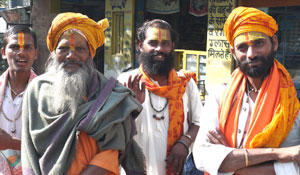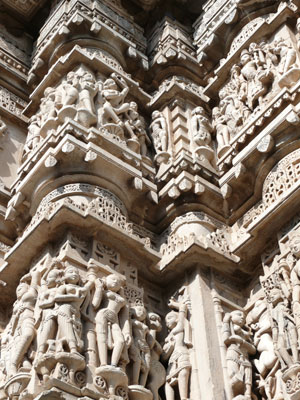UDAIPUR, INDIA - The man in the rumpled suit interrupted his cell phone call just long enough to welcome us to his small craft shop on City Palace Road.
“Good day. Please feel free to wander. I will be with you in a moment,” said the man with the beaming face.
Shopping is one of the great activities for travellers to India and small handicraft shops like the Ganesh Emporium are a treasure trove for those looking to bring something uniquely Indian home.
A quick look around the main floor of the narrow four-storey Ganesh shop (formerly a home located on the street linking two of Udaipur’s most famous landmarks, the City Palace and the Jagdish Temple) suggested we had discovered the mother lode of bargains. Shelves were crammed with handmade Pashmina shawls, sequined dresses, skirts, silk handbags and cushion covers – all intricate in their decorations and design but each modestly priced.
His phone call over, the man introduced himself: “I am Manoj (Ganpat Laxman) and I am the owner of this shop. I hope my staff is tending to your needs.”
We paid little attention to his words at first - we were like kids in a candy store, darting from one side of the shop to the other; grabbing up three purses; two scarves; five pillow covers …
“There are three more floors of merchandise above us …”
Manoj’s words slowed our shopping enthusiasm - for the moment – and for the first time since arriving we noticed his shop appeared different from others we had visited during our week-long trip through incredible India.


Left: The people of Udaipur are always willing to pose for a photograph. Right: The lovely buildings that make up Udaipur are beautifully decorated.
Along with piles of merchandise, we could see through an open door some museum-like pieces – ancient wooden doors, old window frames, dated pottery and weathered tapestries – scattered about an interior courtyard.
It was then we discovered the likeable Manoj wasn’t just a shopkeeper; he was attempting to become the keeper of Udaipur’s textile past.
"I have been going through the neighbourhoods and villages collecting these old pieces; trying to preserve them for use in the artisan shop I am building next door," said Manoj, who invited us to follow him through a labyrinth of rooms being renovated in a building connected to his shop.
“I am purchasing the buildings and refurbishing the rooms so local artisans can showcase and sell their works to visitors like you,” said Manoj, who told us he was exporting some of the locally designed garments to “Montreal and soon Vancouver” but not Toronto – “at least not yet.”
“I sell some of the artifacts to help finance the project,” he said. “In fact, I will sell you these doors for $600 – they are over 300 years old.”
Even antiquities are bargains in India.
Back in his shop after the short tour of the restoration area, Manoj rolled out beautiful fabric and assured my female travelling companion that “I will have my man take your measurements; make you a sari this afternoon; and deliver it to your hotel this evening.”
Promptly at 7 p.m., the perfectly tailored silk garment arrived.
Cost?
“Fifty dollars,” said Manoj, who tallied up the rest of our purchases and announced: “That comes to $250 - U.S.” My companion was giddy with excitement.
“Do you know one of those Pashmina shawls we just bought (there were 10 in our bags, along with purses, a jacket, cotton blouses, lots of pillow covers, a striking beaded table cover and silver handcrafted earrings) would cost at least $200 each back home,” she whispered.
Our visit to Manoj’s shop only whetted our appetite for more Indian treasures and in each stop along our journey we discovered equally impressive and affordable finds.
In New Delhi, for example, at the Cottage Industries Exposition (CIE) Ltd. carpet shop on Anand Lok Road, we bought three hand woven Kashmir rugs for half what they would cost in a Toronto shop.
"These rugs take years to make and are hand woven by a single family," the salesman at CIE said while reassuring us no child labour was used in the making of these remarkable works of art, which we decided were too precious to lay on a floor – they now occupy space on our living room wall.
“We will supply proof to your customs people that no child worked on these carpets,” said the man, who added: “we will also supply you with a certificate telling the history of the Kashmir family who designed your rug.”
In Agra, home of the Taj Mahal, we fell in love with the beautiful leather goods offered in the city’s old market – stunning bags made from soft goat and sheep skin and inlaid with intricate patterns. The narrow streets of Agra’s old town were filled with tiny shops, some not much bigger than a phone booth. They sold everything from shoes to silver - sterling silver chains, bracelets and earrings are weighed and then sold for just pennies a gram – and of course we filled our bags with as much as we could carry.
Jaipur was where we discovered India is the emerald and semi-precious stone capital of the world. Rings, necklaces and broaches – all beautifully designed – cost just a fraction of what they’re worth in Canada, so we stocked up on Christmas gifts for family and friends.
By the time we reached Mumbai (Bombay to the locals), we had little money or room in our suitcases left, which was a shame because the bargains we purchased in other cities and towns along the way were offered at even lower prices in the shops located behind the famed Taj Mahal Palace Hotel.
On our way to check out Mumbai’s famed Leopold Café and Bar – a fixture in the great city since 1871 – we were tempted to buy even more bargains by street vendors who politely offered their wares at prices that were ridiculously low.
We thought we were safe from shopping when we were taken on a walking tour through Mumbai’s bustling Crawford Market, where mostly food and spices are sold. But when a man approached and offered to sell us precious saffron for just pennies a gram – the spice is literally worth its weight in gold back home – we stocked up.
“Good bargains in India,” stated the vendor as he bagged our three containers of saffron.
“Can I help you with anything else?” he asked.
“Yes,” I replied, “can you tell me if there’s a shop in the market that sells suitcases?” Shopping in India is indeed the spice of life.